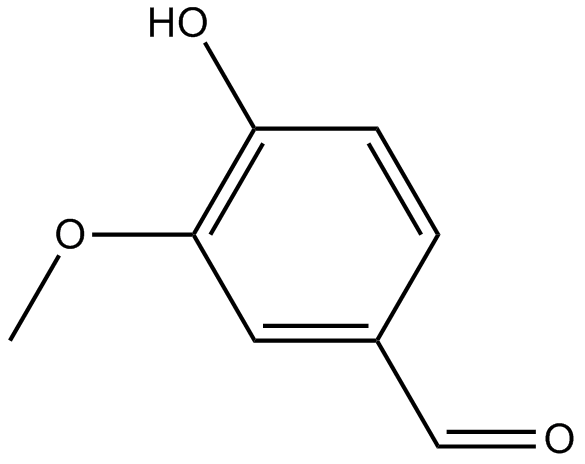Vanillin (Synonyms: 3-methoxy-4-Hydroxybenzaldehyde, NSC 15351, NSC 403658, NSC 48383) |
| Catalog No.GC14055 |
flavorant
Products are for research use only. Not for human use. We do not sell to patients.

Cas No.: 121-33-5
Sample solution is provided at 25 µL, 10mM.
Vanillin (p-Vanillin) is a single molecule extracted from vanilla beans and also a popular odor used widely in perfume, food and medicine.
Vanillin recovers UVA-induced reduction of proliferation in a dose dependent manner. Vanillin has no apoptotic effects at the tested concentrations. In addition, the reduced expression levels of OCT4, NANOG, and SOX2 caused by UVA irradiation are all increased by Vanillin treatment, suggesting that Vanillin attenuates the effects of UVA irradiation on hAMSCs. Based on a luciferase reporter assay, Vanillin increases the reduced activity of HRE-luciferase reporter caused by UVA irradiation. In addition, treatment with Vanillin attenuates the reduced expression of HIF-1α caused by UVA irradiation. The results reveal that treatment of hAMSCs with Vanillin results in significant decrease in the production of PGE2 and cAMP when compare to UVA-irradiated controls[1].
Following antidepressant treatment for 4 weeks, immobility time in the stress+Vanillin and stress+fluoxetine groups is significantly decreased [F(4,42)=34.73, P<0.01; F(4,42)=13.55, P<0.01, respectively]. Treatment with Vanillin or fluoxetine remarkably alleviates the decrease in sucrose consumption in CUMS model animals [F(4,42)=12.32, P<0.01; F(4,42)=5.65, P<0.01, respectively]. In CUMS model rats, 5-HT level in the stress+Vanillin and stress+fluoxetine groups is significantly increased when compare with the stress group [F(4,42)=4.846, P=0.030; F(4,42)=4.846, P=0.036, respectively], whereas noradrenaline (NE) in the two groups is elevated but not significantly [F(4,42)=6.977, n.s.]. Dopamine (DA) is also significantly increased in the stress+Vanillin group compare with the stress group [F(4.42)=6.174, P=0.041][2].
Reference:
[1]. Lee SY, et al. Vanillin attenuates negative effects of ultraviolet A on the stemness of human adipose tissue-derived mesenchymal stem cells. Food Chem Toxicol. 2016 Oct;96:62-9.
[2]. Xu J, et al. Vanillin-induced amelioration of depression-like behaviors in rats by modulating monoamine neurotransmitters in the brain. Psychiatry Res. 2015 Feb 28;225(3):509-14.
Average Rating: 5 (Based on Reviews and 14 reference(s) in Google Scholar.)
GLPBIO products are for RESEARCH USE ONLY. Please make sure your review or question is research based.
Required fields are marked with *




















